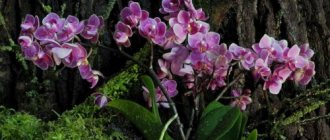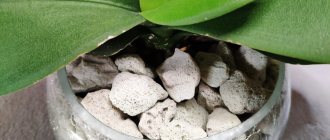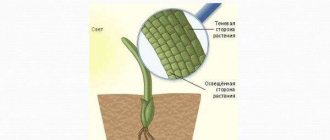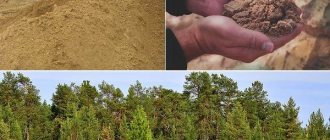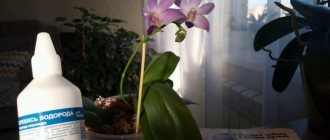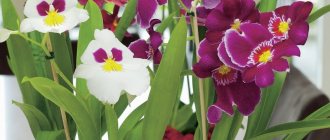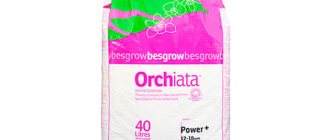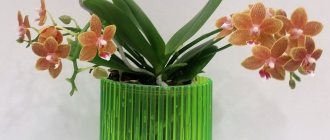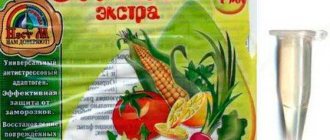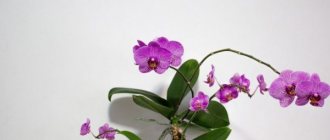Interesting facts from the history of the plant:
- on Earth 130 million years ago ! Scientists prove this;
- Their appearance in Japan and China more than three thousand years ago is confirmed by many documents;
- The first work, “Knowledge of Plants” by the Greek literary botanist Theophrastus, where the word “Orchis” is mentioned, appeared more than two thousand years ago;
- You can find natural habitats of these plants on all continents. But not in Antarctica ;
- Most species live in the mountains and forests of the tropics . The climate favors their existence. Enough sun, plenty of rain, high temperature and humidity;
- These plants can be epiphytes (living on trees as supports), or less often lithophytes (living on rocks).
But creating conditions for growing tropical beauties is not easy. Miscalculations in care lead to various diseases.
Abiga Peak
Abiga-Pik is perhaps the most common contact fungicide. It has earned its popularity due to its wide spectrum of action. Thanks to copper oxychloride, which is part of it, the drug copes well with a large number of infections caused by fungi. It does not cause resistance; it can be used in various conditions, including at home.
The drug is produced in the form of a suspension, which is easily diluted in water. It is recommended to spray sick indoor plants with Abiga-Pik fungicide 3-4 times with an interval of 10 days. To prepare the solution you will need 5 ml of product per 1 liter of water. Preventative treatments should be carried out before plants begin to flower.
How to use the drug
Fungicides for phalaenopsis orchids can be applied in various ways, for example:
- dilute in water and spray the diseased flower with a spray bottle, thus having a destructive effect on fungal infections;
- treat the soil, thereby destroying the microorganisms living there; to do this, dilute the powder in water for irrigation and moisten the soil with the resulting solution during reforging;
- during a planned orchid transplant, it is treated with this product in dry form.
The life-giving effect of fungicides can be noticed just a few days after the initial treatment.
Oksikhom
Another copper-containing fungicide with wide application. In addition to copper hydroxide, the manufacturers included a new agrochemical, oxadixil. Due to this combination, the drug received not only a contact, but also a systemic effect. By acting on pathogens, it simultaneously destroys them and suppresses cell division, which stops the development of spores. The pesticide is a fast-acting substance (the effect on the infection begins in the first 2-3 hours), and it has a long-term preventive effect.
Oxychom is produced in the form of a wettable powder. For spraying indoor plants, a solution of 2 grams of product per 1 liter of water is usually used; to treat red burn of bulbous plants (amaryllis, hippeastrum) you will need 2 times more of the product. Treatment is carried out up to 3 times every 10 days. Since copper hydroxide tends to settle, the finished liquid must be stirred periodically during the procedure.
Instructions for use
Each fungicide has instructions for its correct use. If it is not indicated on the label, ask the seller. And follow the recommendations.
Watering the substrate
- Experts recommend watering fresh substrate when planting (transplanting) orchids. We need to let it dry;
- It is better to replace the contaminated substrate;
- Orchids need to change them every 2-3 years. Watering with fungicide is carried out after normal watering..
Fungicides are applied after watering.
Spraying
- Spray with fungicides in the morning . Good sprayers;
- Carry out the treatment outdoors, on the balcony (loggia). Outside residential premises;
- And ventilate the premises. Components that are beneficial to a plant are not always beneficial to humans;
- It is better to use biological products.
Soaking the roots
For this processing method, prepare solutions with higher concentrations . Carry them out when planting (transplanting) plants.
Vectra
For protective and therapeutic effects, the contact-systemic fungicide Vectra is also used. The pesticide contains dichlorophenyl and triazole. The active ingredients stop the further development of the infection, suppress the sporulation of pathogens and heal the plants. The drug is low-toxic and economical to use.
The agrochemical is supplied for sale in ampoules of 2 and 5 ml of ten percent suspension concentrate. For use at home, dilute 1-1.5 ml per 5 liters of water. Treatment is carried out by spraying 3 times every 10 days.
Vitaros
This contact-systemic fungicide is used only for preventive treatment of seeds, bulbs, tubers and other planting material. Thiram and carboxin, the main substances of the drug, provide growth-regulating and long-lasting, up to six months, protective effects.
The product is available in the form of a concentrated suspension in ampoules of 2 ml and in bottles of 10 to 100 ml. The procedure for soaking the biomaterial takes 2 hours. To prepare the solution, 10 ml per 5 liters of water is required. Thanks to the bright dye included in the pesticide, the processing process is noticeably easier.
The use of Vitaros in the treatment of orchids
Treatment with Vitaros, common to all plants, is not suitable for delicate orchids, since the maximum possible exposure of these flowers in the working solution is no more than 10 minutes. If foci of infection with Alternaria or phyllosticosis are detected, the damaged areas are smeared with a fungicide solution, and the rhizomes are also dealt with when black rot appears. In cases where the infection has spread throughout most of the plant, but the root system can still be saved, the root is cleaned from diseased areas and planted in fresh soil, after having spilled it with a solution of the drug.
Pests in the substrate
Now let's move on to the pests that live in the plant substrate. They can be detected only by specific traces and signs.
Slugs and snails
You can tell about the presence of slugs and snails by the silvery trails on the leaves. They love moisture and warmth. They eat leaves and young roots, as well as buds and shoots. These pests can only be seen at night, since during daylight hours they hide in the substrate. Slugs reproduce very often and in large numbers, so constantly collect them by hand, using a cucumber or apple as bait.
To free the plant from slugs and snails, place the pot in warm water for a couple of hours. The pests will crawl out and you can collect them. If you collect them this way for a week, you can get rid of these slippery creatures.
IMPORTANT! It is important to remember that eggs may hatch into new slugs and snails. Therefore, carefully monitor your plant in order to help it in a timely manner. After destroying the parasites, be sure to replant the orchid in new soil!
Podura (springtails)
Podurs (springtails) are small insects that look like light-colored caterpillars that feed on plant debris. Their body length does not exceed 1 cm (these are the largest specimens).
ATTENTION! Podura appear when there is excessive watering: moisture stagnates on the surface of the soil, forming silty deposits where pests live. If the colony of insects becomes very large, poduras can damage young roots.
To get rid of springtails, you can fill the pot with the orchid so that the water completely covers the planting container. The insects will float to the surface and you can catch them from the surface of the water. Also be sure to wash with soap all the trays, shelves on which the plants stood, and the pots themselves. For a period of up to five months, you need to replace the top layer of soil (3-4 cm) with sand or ash. To treat the soil, you can use Aktara or Fitoverm solutions. If there is a large population of grasshoppers, you should definitely reduce watering.
Sciarids (fungus gnats)
Sciarid fungus gnats are attracted to weakened plants with a damp, decaying substrate, or a tray with stagnant water. You often bring these midges into your house with contaminated soil, a bouquet of flowers or spoiled vegetables.
ATTENTION! The appearance of sciarids indicates constant waterlogging of the soil.
Fungus gnats are not as dangerous to the flower as their larvae, which feed on the roots. The plant stops growing, blooming and dies. It is clear that to save a plant, you need to transplant it into a fresh, uninfected substrate, having first carefully examined the root system of the flower. If necessary, wash the roots with a weak solution of manganese. The newly transplanted plant should be watered no earlier than after five days. Getting rid of sciarids should begin with adults, using aerosol fly sprays. The treatment should be repeated until the midges completely disappear, so that they cannot lay new larvae. At the same time, we recommend drying the substrate and watering the plant with chemicals to kill pests at any stage of their development.
Root mealybug
The root mealybug has an oval body of a pale pink or grayish hue. These bugs grow up to 4 mm in length and feed on the roots of the plant, sucking out the root sap.
The root bug prefers substrates with good air exchange and does not tolerate heavy watering very well. The foliage loses its luster and the plant becomes lifeless. At the final stage of the disease, the leaves look wrinkled and withered. Since this pest can only be seen visually when replanting a plant, by the time you realize that the bush has been attacked by parasites, all nearby flowers will already be infected.
There are no other methods of getting rid of root scale insects other than replanting the plant in a new pot and fresh soil. Of course, before planting the flower, you should wash and disinfect the roots. The previous substrate and soil must be removed.
Discor
A systemic chemical fungicide is actively used in indoor floriculture. Its active ingredient difenoconazole has a high degree of activity and quickly suppresses the vital processes of pathogens. The drug can be used at any phase of plant development, including during the period of swelling of buds and during flowering. Depending on the infection, treatment is possible by spraying and watering the soil. Also, seed treatment is recommended as a preventive measure and to increase germination.
Discor is produced for home use in the form of an emulsion concentrate, volumes of 2 and 10 ml. For spraying to treat most diseases, 1 ml of product per 5 liters of water is sufficient, to combat gray rot - 2 ml, and for bacterial spots, 2.5 ml per the same volume of liquid is required. The procedure is repeated after two weeks, reducing the concentration of the solution by 2 times.
Precautionary measures
Orchids react very sensitively to chemical components contained in water, air, and fertilizing. Therefore, you should pay close attention to each element of care.
Water requirements
Tap or spring water may contain chemical compounds that are not beneficial for orchids, such as chlorine or zinc.
The best water is considered to be rainwater, melt water, and distilled water. Chlorinated water can be used, but it must first be left in an open container for at least a day.
Overdose: risks, consequences, methods of leveling
Overdose can occur due to:
- one-time use of a solution with an excess amount of Agricola;
- accumulation of fertilizer in the substrate and on the roots for a long time.
Overdose can lead to:
- to burns and death of roots;
- to a sharp reduction in the number of flowers or a complete refusal to bloom, in difficult cases - for several years;
- to growth retardation, developmental disorders;
- to excessive growth of green mass;
- to the growth of twisted, deformed leaves;
- to thickening, and then to cracking of the pseudobulbs.
Excess fertilizer can cause leaf deformation.
To reduce risks, it is recommended to take non-chlorinated water, preferably melt or rain water. In addition, it is more correct to use a slightly lower concentration of the feeding solution than indicated on the package, for example, not 5, but 2.5-3 ml per liter.
If an overdose does occur, the orchid should be removed from the pot, the roots should be washed with clean warm water, and the plant should be placed in a fresh substrate. Cancel any feeding for several months.
Fitosporin-M
The systemic fungicide Fitosporin-M is a preparation of biological origin. The waste products of Bacillus subtilis, which make up the active ingredient of the pesticide, suppress the proliferation of pathogens that cause diseases. The breadth of use of the biofungicide is noted by both gardeners and home gardening enthusiasts. At the same time, it has low toxicity for humans and animals and is absolutely non-phytotoxic. It is possible to spray plants at any time during the growing season, as well as watering to treat the soil, and soaking the seed material and root system of seedlings before planting.
Three forms of the drug are available, differing in the number of bacteria per unit of substance and solubility in water.
- The powder has the largest number of spores and living cells, but it does not dissolve well and requires pre-soaking 1-2 hours before treatment. For prevention, spraying is carried out with a solution of 0.5 teaspoon (1.5 g) per 2 liters of water, for treatment: the same amount of the drug, but per 1 liter of water. For soaking and watering, dilute 2 grams in 1 liter of water.
- The biofungicide is easily diluted in paste form, but it has the lowest bacterial titer. To water the soil, use 15 drops of the substance per 1 liter of water, and 10 for spraying.
- The average between the two previous forms is an aqueous suspension, which also has a gentler effect on plants. The solution for all types of its use will be the same: 10 drops of fungicide per 1 glass of water.
Baktofit
The broad-spectrum drug “Baktofit” also belongs to biofungicides. Its active ingredient is Bacillus subtilis strain IPM 215. The bacterium is also called “bacillus hay.” It produces an antibiotic, which becomes destructive for pathogenic fungi. But this requires certain conditions. The air temperature should not exceed +25° C, and the microorganism requires additional nutrition, which can be added in the form of mulch, for example: crushed bark or wood chips. Also, the bacteria does not tolerate chlorine, so it is recommended to let tap water sit before use.
The drug is produced in the form of powder and suspension concentrate. For watering indoor plants, the solution is prepared in the ratio: 3 ml (1 g) of fungicide per 1 liter of water. For spraying against various spots, 1 ml (1 g) per liter of water is used for the working fluid. The procedure is repeated up to three times every 10-12 days.
Sooty fungus (niello)
Sooty fungus , or as it is also called Black or Chern , is named directly because of its color, namely black as soot.
Sooty fungus or niello on orchid
This fungal disease does not occur on its own or due to improper care. If you notice black spots on your orchid, this means that you are seeing the consequences of the orchid having neighbors. White scale insects, mealybugs or aphids have certainly settled with your beauty. They leave their secretions on the plant, on which this fungus begins to grow.
This fungus completely clogs the stomata of orchid leaves, blocking their access to light. If you do not start prompt treatment, the fungus will very quickly attack the entire plant and it will die; saving such a plant will simply not be possible.
As a treatment, urgently treat the orchid with one of these drugs: “Rodomil Gold”, “Mikosan”, “Skor”, “Topsin-M”.
Move the diseased plant as far as possible from other plants, especially orchids. Be sure to change the soil. When replanting, be sure to wash the roots and sprinkle them with activated carbon powder or cinnamon.
Agat-25K
Biofungicide "Agat-25K" can be called a drug with multisystem action. It is created on the basis of waste products of bacteria Pseudomonas aureofaciens H16; in addition, the manufacturer added bioactive substances, micro- and macroelements, and active fractions of pine extract to the composition. Thanks to this complex of components, plant immunity is increased, thereby developing resistance to infection, as well as activating the growth of crops and increasing their resistance to adverse factors. The fungicide is safe for both humans and animals, as well as the environment, and has a beneficial effect on the root zone, acting as a fertilizer. The drug combines well with other agrochemicals, and when used together with herbicides, it reduces their negative effects.
In the retail chain, the product is presented in a dark paste form, placed in a syringe with a measuring scale. The solution is prepared in two stages: first, the required amount of biofungicide is diluted in a small amount of water, then the resulting liquid is added to the filled sprinkler. To treat indoor plants, only 3 grams of the drug are required per 10 liters of water. Spraying is carried out 2 times a month.
The table below shows the most common fungal diseases, the houseplants they affect, and the most popular fungicides.
Fusarium orchid blight: signs and treatment features
Fusarium plant blight is a dangerous disease. Its existence became known during the Second World War. Significant damage was caused to the agricultural industry. It turned out that after an infection, the fruits of the plants become inedible. It took many years to find the cause and treatments. Indoor orchids phalaenopsis and calantha, cylagina and paphiopedilum, brassia and cattleya, cymbidium and oncidium, any varieties, ordinary and exhibition specimens can get it. Two types of fungi from the Fusarium family are dangerous - Fusarium solani and Fusarium oxysporum.
Signs of fusarium in orchids
Fusarium orchid blight is easy to recognize. The first signs are weak turgor of leaves and stems and lack of flowering. Soon a symptom such as irregularly shaped spots appears. At first they are yellow in color, then darken. A brown or black border appears, characteristic of infections caused by mold fungi.
The spots turn into thinned depressions. Their area is gradually increasing. They can appear both on the lower stems and on the upper ones, on the outside or inside of the leaf blades. This depends on how exactly the spores entered the plant - through the air or with contaminated soil, during contact with infected garden tools, or in another way.
Description of indoor plant
Perennials of the Orchid family have firmly won the hearts of indoor flower lovers. There are thousands of species of orchids in the world, but no more than twenty of them can grow indoors. The plant's homeland is the tropical forests of America and southeast Asia.
Most of them live at the expense of other green fellows located in the neighborhood. Therefore, the roots of orchids are not in the ground, but hang down, receiving nutrition from the bark of trees, the herbaceous layer of soil, and moist air. They are classified as epiphytic plants. It is these varieties that can adapt well to indoor conditions. There are other types of orchids that adorn the rocky cliffs.
The main feature of representatives of epiphytes is a thickened stem, called a pseudotuber.
The ovoid or cylindrical tubers are connected by a thin rhizome. Flowers are located on long peduncles extending from pseudotubers. Their size and color depend on the plant variety. The decorativeness of the flower is in its structure: on the outer side there are two lateral and one upper sepals, on the inner side there is one petal tongue surrounded by lateral ones. This tongue, or delicate lip, of the flower, with its brightness, attracts insects and birds that pollinate orchids.
The lower part of the plant is decorated with dark green leathery leaves, which always look fresh and attractive. This beautiful perennial also requires special care, since it is highly susceptible to unfavorable growing conditions.
Features of treatment of fusarium orchid blight
To date, fusarium has been well studied by scientists. Drugs have been invented to combat it with different principles of action, delicate and potent, bio-based and chemical. They are called fungicides. But in the case of this flower, most of them are not recommended to be used or act with caution. They are only suitable for spraying the above-ground parts.
Mushroom helping orchid
The root system of an orchid may contain microfungi. They help her survive and grow. Absorb nutrients from the soil, improving nutrition of the root system. The relationship is symbiotic, that is, beneficial for both species.
Microbial fungi cannot stop the disease and the proliferation of fusariums, but they increase the flower’s chances of survival even in depleted soil and difficult conditions. When treating the soil with any antifungal drug, their spores may also die. This will be an additional, very strong stress for the plant’s immune system.
It is allowed to spray the above-ground part of an indoor orchid with such popular means as Fitosporin, Fundazol, Baktofit, Hom, Maxim, Sutomai, Daconil, Benlat.
Deserves special attention
Source: mirekzotiki.com
Topudzhin-M paste is applied directly to fungal-affected areas of leaves and stems. The effectiveness and convenience of treating fusarium in indoor orchids with it has been confirmed by many gardeners.
The disadvantage is resistance. With prolonged use, the Fusarium mushroom may develop immunity to it. The main active ingredient is methyl thiophanate.
Treatment of orchid roots
Treating foliage, stems, and infected areas with one of the fungicidal preparations will help slow down the development of fusarium. Fusarium fungi, the causative agents of infection, penetrate the plant cells and the vessels through which the sap circulates.
It is important to stop their spread and this can be done by spraying and applying paste.
If the roots and soil are infected, the situation becomes more complicated.
To cure an orchid, you should check the condition of the roots:
- remove it from the previous soil;
- wash the foliage and roots in water at room temperature;
- remove root shoots and leaves damaged by the fungus, if possible;
- Sprinkle the cut areas with cured activated carbon;
- 3-4 hours after this, carry out spot treatment with a fungicidal preparation;
- transplant into a new flower pot, soil not contaminated with fungus, or into a container with a hydroponic solution.
Fusarium mushrooms can cause irritation on human skin, dermatitis, and an allergic reaction. Therefore, you must use gloves and wash your hands with soap after completing the procedure.
In a situation of severe infection of the root system, new shoots can be sprouted. To do this, orchid stems are placed in a vessel with moss. The flower is periodically sprayed to provide nutrition and maintain vitality. The use of anti-stress medications will speed up the recovery process.
Hydroponics and fusarium
The hydroponics method is considered the most harmonious and safe way to grow flowers. It is universal and relevant in the case of indoor orchids. Despite the benefits, it will not protect against fusarium. These mushrooms are anaerobic. They thrive in both soil and water. Their spores can be carried by wind and raindrops.
The hydroponic method is preferable for other reasons. It will be easier to replace the water in the flowerpot than the soil. It becomes possible to examine the symptoms on the root system and control the situation.
What fungicides are used for:
Diseases of the root system
It’s not for nothing that experts advise planting orchids in transparent containers. Not many plants have roots that can be visually inspected without being removed from the pot.
You may find that the roots are not doing well.:
- Drying;
- Blackening;
- Decay;
- Their absence is a separate issue.
Before watering the roots with any preparation, determine the disease :
- Viral diseases (small spots or stripes) cannot be cured. They may come to you with new pets. No matter how sorry it is, they will have to be destroyed (burned);
- But you can deal with bacterial (liquid is released from the ulcers) and fungal (pink or yellow plaques): Remove damaged and dried roots;
- Treat the sections with antibacterial drugs (ash, potassium permanganate, activated carbon, sulfur powder);
- Use copper-containing fungicides;
- Very effective: Fundazol;
- Topsin;
- Maksim;
- Fitosporin.
Watering the contaminated substrate
For these purposes, it is correct to use drugs that have a strong eradicating effect (soil fumigants). Contact ones are more commonly used :
- Vitavax;
- Maksim;
- Fitosporin;
- Trichodermin;
- Gaupsin.
One of the forms of Gaupsin release.
In the treatment of fungal diseases
Use not only the above drugs for this. But it is better to purchase them in specialized stores . And not from trays with advertisements throughout the market: “Kills everything!”
Important! It is necessary to alternate between different fungicides. Long-term use of the same drugs causes addiction in pathogens. And it reduces the effectiveness of the drug to counteract them.
Disease prevention
A well-groomed plant, which has enough nutrients, sunlight, and warmth, will show a greater degree of endurance and will more easily accept treatment. Prevention will save you from worry. Flower growers and orchid fans need to focus on this. Moreover, there are effective preventive methods that provide a 100% guarantee.
On a rainy day
Fusarium spores are most active in cold weather, after rains. If it suddenly gets colder in the summer, the sun is hidden behind thunderclouds, it is advisable to turn on the air conditioning, close the vents and windows. Fusarium mushrooms are a common microorganism in nature. They can live in any country, in any region.
How to make an orchid bloom? Or a photo of the results on my flowers
In this review I will talk in detail about Bona Forte orchid fertilizer .
There are about 27 plants in my orchid collection. To tell the truth, I have already lost count, some unfortunately die, some have babies, some I divide into several independent plants.
In my collection you can find Phalaenopsis, various Cambria, Dendrobium, Zygopetalum, Lusidia and Joveara. Links to detailed reviews can be found below.
And, if you are breeding or maintaining indoor plants, then sooner or later the time comes. when they need to be fed, or simply fertilized.
On sale you can find many different products for fertilizing orchids, but I give my preference to Bona Forte fertilizer for orchids .
In this series of fertilizers you can find two series, they differ in the color of the caps and the effect on plants:
1 Series “Beauty” – stimulates flowering (red cap, my review about it),
2 “Health” series – increases plant immunity (purple cap).
➤➤ What microelements affect the duration and density of flowering?
The main components of fertilizers are nitrogen and phosphorus.
The more phosphorus in the fertilizer, the more abundant the flowering will be.
The more nitrogen, the more green mass will grow.
When purchasing any fertilizers for plants, you need to focus on these elements and the result you want to achieve.
If we consider the composition of series No. 1, we can see that Nitrogen is in first place - 4% , in second place is phosphorus - 2.5% .
– Three main macroelements (NPK): nitrogen (N)-4%, phosphorus (P2O5)-2.5%, potassium (K2O)-7% – Main meso-element (Mg): magnesium (MgO)-1.3% – Seven trace elements: Boron, iron, manganese, zinc, copper, molybdenum, cobalt. – Of these, six trace elements are in chelated form: iron, manganese, zinc, copper, molybdenum, cobalt. – Vitamin complex: B1, PP, C. – Growth stimulator: succinic acid.
➤➤ How do I use fertilizer?
In spring, summer and autumn I use fertilizer through watering. I water on average (if we consider phalaenopsis) once every 7-10 days.
In winter - once every 3-4 weeks.
I dilute the fertilizer 1/4 of a cap in 1.5-2 liters of water.
The fertilizer has a bright green color and a not strong, not unpleasant smell.
IMPORTANT. I use fertilizer only on wet roots. Otherwise, the fertilizer may cause burns on the roots.
The manufacturer also recommends using fertilizer to spray the leaves.
Foliar feeding: dilute 1/8 cap (5 ml) in 3 liters of water. Spray the surface of the leaves until completely wet, avoiding getting the solution on the flowers.
I haven't used this method. In general, I try not to spray my orchids, but if the leaves become dirty, wipe them with a damp cloth.
This way there is less chance that water will get into the axils of the leaves and the plant will begin to rot.
➤➤ General information:
➤ The volume of the bottle is 285 ml , it is consumed economically, one bottle lasts for about 3-4 months with regular use.
➤ Shelf life – 4 years , you can use the fertilizer after the expiration date.
➤ Fertilizer price
➤➤ My impression:
About 1 week after using the fertilizer, many flowering “pips” appeared, root activity intensified, young leaves appeared, and the number of buds increased compared to the previous flowering.
I’ll supplement the review with photos of my beauties:
I recommend Bona Forte fertilizer for orchids, I will buy more and recommend it to everyone.
➤➤ Read how I care for my orchids here:
Precautionary measures
Protection zones for Vitaros as an industrial disinfectant are not assigned; they are the same as for seed factories. PPE employees of the enterprise are issued with full protection from those available, see fig. Workers involved in processes using thiuram must undergo periodic medical examinations according to the general rules for those working with pesticides.
Personal protective equipment for working with Vitaros in industrial conditions
Thiuram is very resistant to acids, alkalis and external conditions - it does not lose its toxic, carcinogenic and mutagenic properties when heated to 300 degrees Celsius. Taking into account the above “charms” of this substance, PPE for treating flowers with Vitaros in non-industrial conditions must be used to prevent the drug from getting on the body and, especially, on the mucous membranes and conjunctiva of the eyes (see also the following figure):
Personal protective equipment for non-professional work with Vitaros disinfectant
- Over work clothes that completely cover the body, you need to wear a plastic raincoat with a hood (preferably with sleeves). Fastener – plastic zipper (zipper) with wide cast teeth; A zipper made of a flattened plastic spiral does not guarantee against the drug getting on the body. If the hood does not have an elastic band, it needs to be inserted to fit it tightly around the face. At the end of the work, the cape is soaked in table vinegar for at least 1.5-2 hours and then washed with water. But it is best to use a disposable cape, which is then destroyed in the incinerator.
- For your face, you need to purchase a biker balaclava mask from a bike shop for riding in bad weather. You can breathe through it, but it does not allow droplets of moisture to reach your face. At the end of the work, wash the mask in the washing machine, setting its dial to the “Heavily soiled laundry” or “Sportswear” position.
- The eyes are protected with plastic safety goggles. At the end of the work, they are soaked in vinegar and then washed, but it is better to purchase disposable medical glasses at the pharmacy.
- There, at the pharmacy, you can purchase disposable latex examination gloves. Upon completion of work they are destroyed.
- The respiratory organs are protected with any filtering respirator. If there was no splash of the drug during operation, the breathing device must be further used after neutralization according to the instructions for it (from settled carboxin vapors). If splashes get on the respirator, it is destroyed. Therefore, it is best to use a cheap disposable petal respirator.
Vitaros fungicide for orchids cannot be stored in household conditions. An ampoule or bottle (for greenhouses) is purchased on the day of use and is used completely. Empty containers and packaging from them are destroyed. Neutralize spills with organic solvents (observe fire safety rules!), followed by rinsing with water.
If the drug gets on your body, you should wash in the shower and consult a doctor. In case of contact with eyes, rinse them generously with open eyes under running water and also consult a doctor, as in the case of any of the symptoms of acute or chronic poisoning: lack of appetite, bitterness in the mouth, headaches, dizziness, memory loss, unreasonable runny nose , deterioration of the sense of smell (the smell from a glass of vodka brought to the nose is almost imperceptible), sore throat, pain in the eyes, accompanied by lacrimation, inflammation of the eyelids, pain in the epigastric and retrosternal areas. Sweating, fever, rapid, irregular heartbeat, drop in blood pressure, difficulty breathing, bronchitis, liver pain, urticaria and other skin inflammations, gynecological disorders and diseases (the list alone is worth it).


